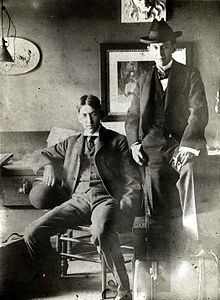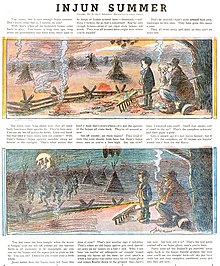John T. McCutcheon
McCutcheon introduced human interest themes to newspaper cartoons in 1902 and joined the staff of the Chicago Tribune in 1903, remaining there until his retirement in 1946.
In addition, McCutcheon, made several trips to Asia, Mexico, Africa, and the Bahamas, where he owned a private island called Salt Cay.
McCutcheon's father was an American Civil War veteran, a farmer, stock raiser, and sheriff of Tippecanoe County.
[3] His older brother was journalist and novelist George Barr McCutcheon (1866–1928), who authored Graustark (1901) and its related books, as well as other literary works.
[5] The McCutcheon family maintained a home in Lake Forest, Illinois,[2] and from 1916 to 1979, owned Salt Cay, a private island in the Bahamas.
[citation needed] In his early years in Indiana, McCutcheon wrote a weekly column of local news for the Lafayette Journal.
McCutcheon urged George Ade, his friend and Sigma Chi fraternity brother, to join him at the newspaper and the two were roommates in Chicago for a few years.
In 1892, McCutcheon and Ade collaborated on "All Roads Lead to the Fair," which were illustrated stories about the World's Columbian Exhibition in Chicago.
[8] His artistic style also transitioned from illustrator to cartoonist beginning with his first published political cartoons during the William McKinley–William Jennings Bryan presidential campaign of 1896.
McCutcheon's five-column work for the front page of the Record-Herald featured humorous cartoons, not merely illustrations of news stories.
"[2] McCutcheon's "Bird Center" cartoons depicted a fictional small town that included a stereotypical cast of characters.
The cartoon was also featured in an Indiana State Fair exhibit in 1928 and as a lifesize diorama and a fireworks display at the Century of Progress International Exposition in 1933–34.
The Indiana Society of Chicago presented a dramatized version of "Injun Summer" in 1920 with McCutcheon's son, John Jr., portraying the young boy.
Despite its popularity, the Tribune began receiving letters of criticism in the 1970s for publishing what some considered as an "ethnically insensitive feature that misrepresented" Native Americans in the United States.
McCutcheon was an eyewitness to the Battle of Manila Bay on May 1, 1898, and remained in the Philippines for several months to report on war before resuming his travels.
[2][8] From 1921 until 1948, McCutcheon served as the first president of the Chicago Zoological Society, overseeing the construction, opening, and early years of Brookfield Zoo.
Although he drew fewer cartoons in his later years, McCutcheon's work appeared on the front page of the Sunday edition of the Chicago Tribune until his retirement in 1946.
Carey Orr, a McCutcheon successor as editorial cartoonist at the Chicago Tribune called him "the father of the human-interest cartoon".
Syndicated columnist O. O. McIntyre once wrote of McCutcheon: "No cartoonist of his or any other time has so influenced public thought and clarified it for better thinking about affairs at home and abroad."







